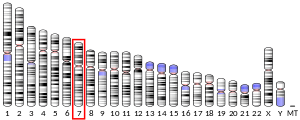CARD11
Caspase recruitment domain-containing protein 11 also known as CARD-containing MAGUK protein 1 (Carma 1) is a protein in the CARD-CC protein family that in humans is encoded by the CARD11 gene.[5][6][7]
Function
The protein encoded by this gene belongs to the membrane-associated guanylate kinase (MAGUK) family, a class of proteins that functions as molecular scaffolds for the assembly of multiprotein complexes at specialized regions of the plasma membrane. This protein is also a member of the CARD protein family, which is defined by carrying a characteristic caspase-associated recruitment domain (CARD). This protein has a domain structure similar to that of CARD14 protein. The CARD domains of both proteins have been shown to specifically interact with BCL10, a protein known to function as a positive regulator of cell apoptosis and NF-κB activation. When expressed in cells, this protein activates NF-κB and induces the phosphorylation of BCL10.[7]
Interactions
CARD11 has been shown to interact with BCL10.[8]
References
- GRCh38: Ensembl release 89: ENSG00000198286 - Ensembl, May 2017
- GRCm38: Ensembl release 89: ENSMUSG00000036526 - Ensembl, May 2017
- "Human PubMed Reference:". National Center for Biotechnology Information, U.S. National Library of Medicine.
- "Mouse PubMed Reference:". National Center for Biotechnology Information, U.S. National Library of Medicine.
- Bertin J, Wang L, Guo Y, Jacobson MD, Poyet JL, Srinivasula SM, Merriam S, DiStefano PS, Alnemri ES (Apr 2001). "CARD11 and CARD14 are novel caspase recruitment domain (CARD)/membrane-associated guanylate kinase (MAGUK) family members that interact with BCL10 and activate NF-kappa B". J. Biol. Chem. 276 (15): 11877–82. doi:10.1074/jbc.M010512200. PMID 11278692.
- Gaide O, Martinon F, Micheau O, Bonnet D, Thome M, Tschopp J (May 2001). "Carma1, a CARD-containing binding partner of Bcl10, induces Bcl10 phosphorylation and NF-kappaB activation". FEBS Lett. 496 (2–3): 121–7. doi:10.1016/S0014-5793(01)02414-0. PMID 11356195.
- "Entrez Gene: CARD11 caspase recruitment domain family, member 11".
- Bertin J, Wang L, Guo Y, Jacobson MD, Poyet JL, Srinivasula SM, Merriam S, DiStefano PS, Alnemri ES (April 2001). "CARD11 and CARD14 are novel caspase recruitment domain (CARD)/membrane-associated guanylate kinase (MAGUK) family members that interact with BCL10 and activate NF-kappa B". J. Biol. Chem. 276 (15): 11877–82. doi:10.1074/jbc.M010512200. PMID 11278692.
External links
- Human CARD11 genome location and CARD11 gene details page in the UCSC Genome Browser.
Further reading
- Hillier LD, Lennon G, Becker M, Bonaldo MF, Chiapelli B, Chissoe S, Dietrich N, DuBuque T, Favello A, Gish W, Hawkins M, Hultman M, Kucaba T, Lacy M, Le M, Le N, Mardis E, Moore B, Morris M, Parsons J, Prange C, Rifkin L, Rohlfing T, Schellenberg K, Bento Soares M, Tan F, Thierry-Meg J, Trevaskis E, Underwood K, Wohldman P, Waterston R, Wilson R, Marra M (1996). "Generation and analysis of 280,000 human expressed sequence tags". Genome Res. 6 (9): 807–28. doi:10.1101/gr.6.9.807. PMID 8889549.
- Sanger Centre, The; Washington University Genome Sequencing Cente, The (1998). "Toward a complete human genome sequence". Genome Res. 8 (11): 1097–108. doi:10.1101/gr.8.11.1097. PMID 9847074.
- Wang L, Guo Y, Huang WJ, Ke X, Poyet JL, Manji GA, Merriam S, Glucksmann MA, DiStefano PS, Alnemri ES, Bertin J (2001). "Card10 is a novel caspase recruitment domain/membrane-associated guanylate kinase family member that interacts with BCL10 and activates NF-kappa B". J. Biol. Chem. 276 (24): 21405–9. doi:10.1074/jbc.M102488200. PMID 11259443.
- Wang D, You Y, Case SM, McAllister-Lucas LM, Wang L, DiStefano PS, Nuñez G, Bertin J, Lin X (2002). "A requirement for CARMA1 in TCR-induced NF-kappa B activation". Nat. Immunol. 3 (9): 830–5. doi:10.1038/ni824. PMID 12154356.
- Gaide O, Favier B, Legler DF, Bonnet D, Brissoni B, Valitutti S, Bron C, Tschopp J, Thome M (2002). "CARMA1 is a critical lipid raft-associated regulator of TCR-induced NF-kappa B activation". Nat. Immunol. 3 (9): 836–43. doi:10.1038/ni830. PMID 12154360.
- Pomerantz JL, Denny EM, Baltimore D (2002). "CARD11 mediates factor-specific activation of NF-kappaB by the T cell receptor complex". EMBO J. 21 (19): 5184–94. doi:10.1093/emboj/cdf505. PMC 129028. PMID 12356734.
- Wang D, Matsumoto R, You Y, Che T, Lin XY, Gaffen SL, Lin X (2004). "CD3/CD28 costimulation-induced NF-kappaB activation is mediated by recruitment of protein kinase C-theta, Bcl10, and IkappaB kinase beta to the immunological synapse through CARMA1". Mol. Cell. Biol. 24 (1): 164–71. doi:10.1128/MCB.24.1.164-171.2003. PMC 303359. PMID 14673152.
- Stilo R, Liguoro D, Di Jeso B, Formisano S, Consiglio E, Leonardi A, Vito P (2004). "Physical and functional interaction of CARMA1 and CARMA3 with Ikappa kinase gamma-NFkappaB essential modulator". J. Biol. Chem. 279 (33): 34323–31. doi:10.1074/jbc.M402244200. PMID 15184390.
- Lee KY, D'Acquisto F, Hayden MS, Shim JH, Ghosh S (2005). "PDK1 nucleates T cell receptor-induced signaling complex for NF-kappaB activation". Science. 308 (5718): 114–8. doi:10.1126/science.1107107. PMID 15802604.
- Shinohara H, Yasuda T, Aiba Y, Sanjo H, Hamadate M, Watarai H, Sakurai H, Kurosaki T (2005). "PKC beta regulates BCR-mediated IKK activation by facilitating the interaction between TAK1 and CARMA1". J. Exp. Med. 202 (10): 1423–31. doi:10.1084/jem.20051591. PMC 2212994. PMID 16301747.
- Sommer K, Guo B, Pomerantz JL, Bandaranayake AD, Moreno-García ME, Ovechkina YL, Rawlings DJ (2005). "Phosphorylation of the CARMA1 linker controls NF-kappaB activation". Immunity. 23 (6): 561–74. doi:10.1016/j.immuni.2005.09.014. PMID 16356855.
- Matsumoto R, Wang D, Blonska M, Li H, Kobayashi M, Pappu B, Chen Y, Wang D, Lin X (2005). "Phosphorylation of CARMA1 plays a critical role in T Cell receptor-mediated NF-kappaB activation". Immunity. 23 (6): 575–85. doi:10.1016/j.immuni.2005.10.007. PMID 16356856.
- Narayan P, Holt B, Tosti R, Kane LP (2006). "CARMA1 is required for Akt-mediated NF-kappaB activation in T cells". Mol. Cell. Biol. 26 (6): 2327–36. doi:10.1128/MCB.26.6.2327-2336.2006. PMC 1430296. PMID 16508008.
- Ishiguro K, Avruch J, Landry A, Qin S, Ando T, Goto H, Xavier R (2006). "Nore1B regulates TCR signaling via Ras and Carma1". Cell. Signal. 18 (10): 1647–54. doi:10.1016/j.cellsig.2006.01.015. PMC 3204664. PMID 16520020.
- Ishiguro K, Green T, Rapley J, Wachtel H, Giallourakis C, Landry A, Cao Z, Lu N, Takafumi A, Goto H, Daly MJ, Xavier RJ (2006). "Ca2+/calmodulin-dependent protein kinase II is a modulator of CARMA1-mediated NF-kappaB activation". Mol. Cell. Biol. 26 (14): 5497–508. doi:10.1128/MCB.02469-05. PMC 1592706. PMID 16809782.



